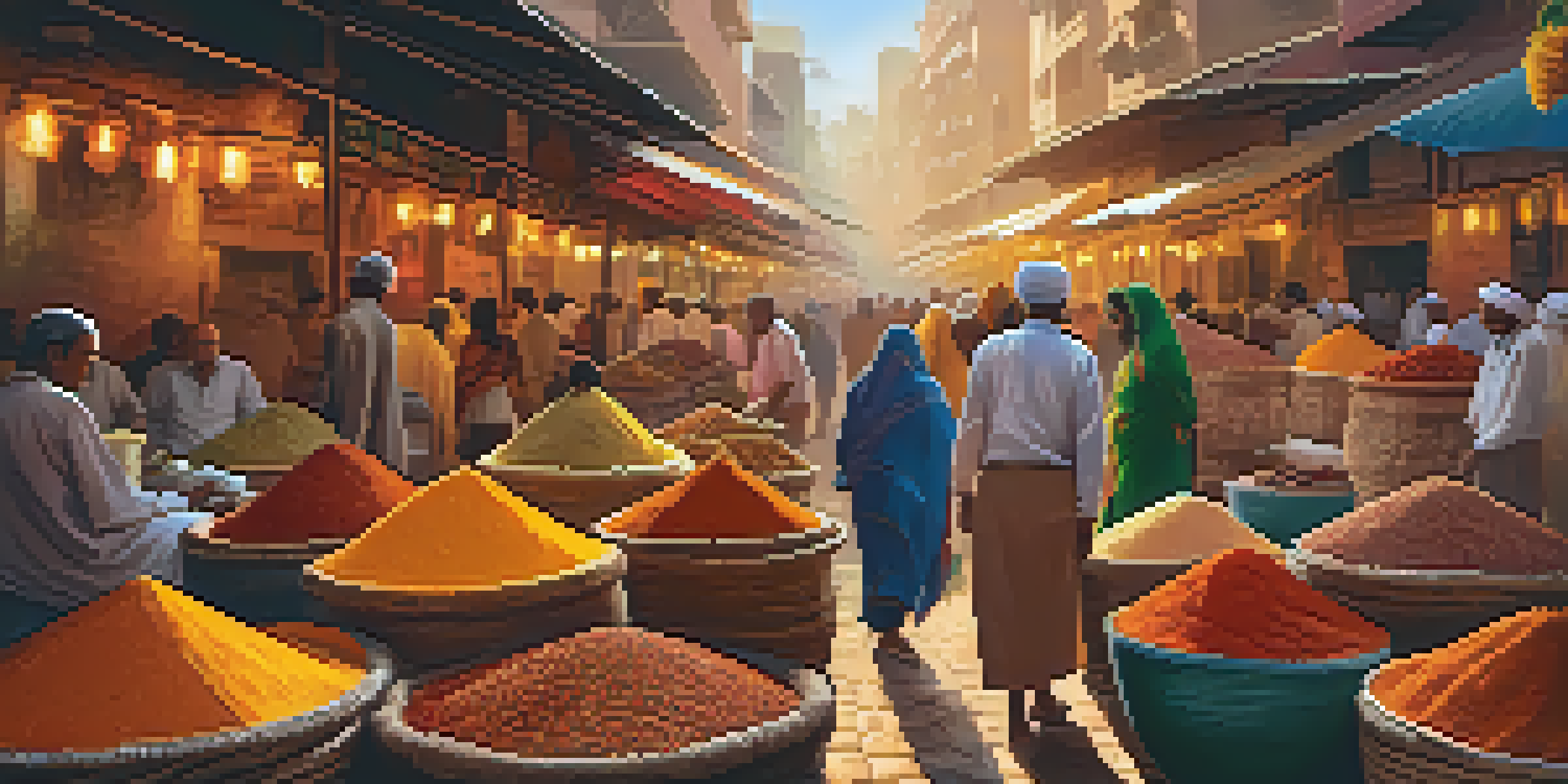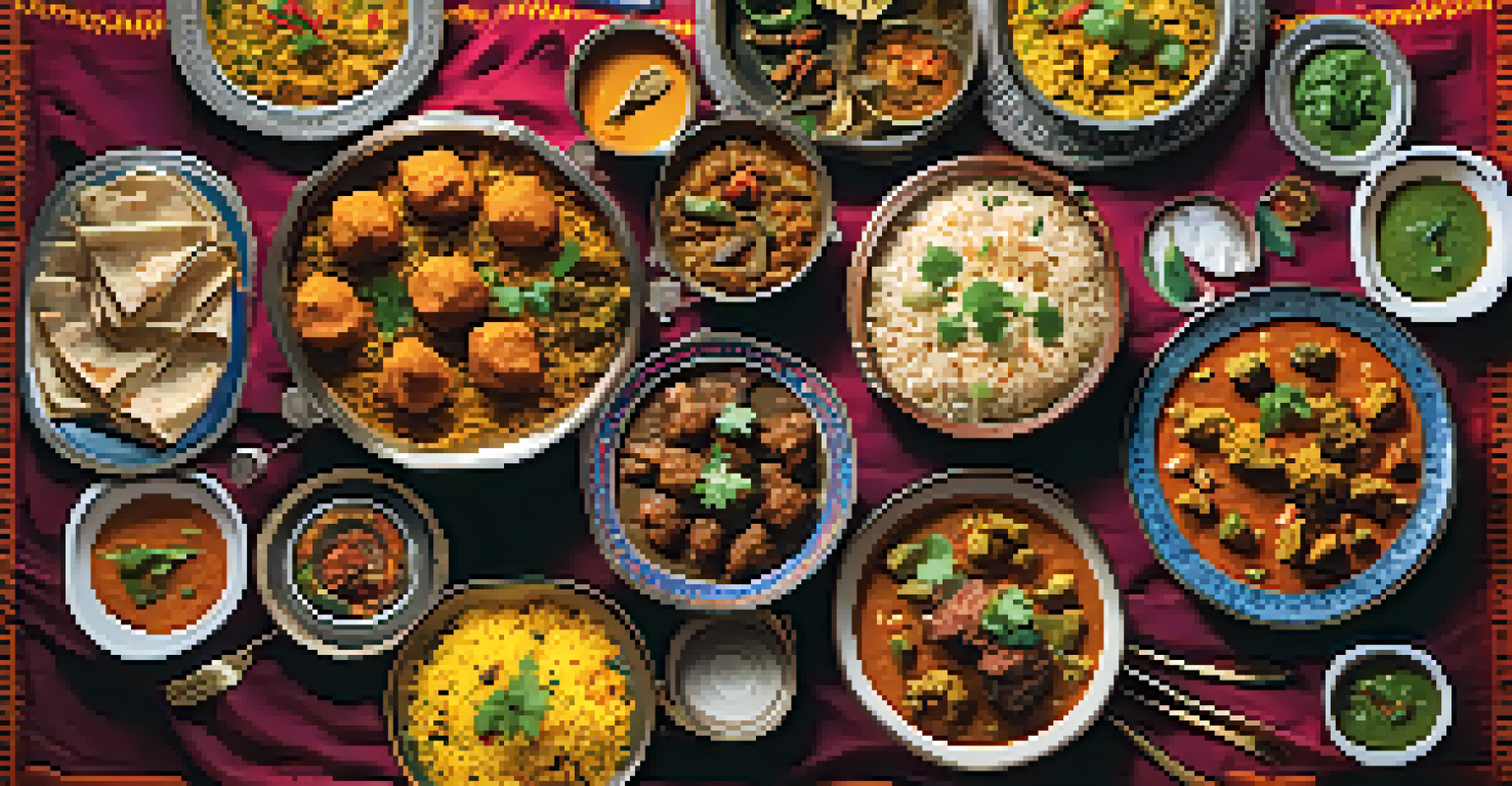Culinary Influences: How Trade Shaped Indian Cuisine

The Spice Route: India's Culinary Gateway
The Spice Route was crucial in establishing India as a culinary hub. This ancient trade network connected India to various parts of the world, allowing spices such as black pepper, cardamom, and cinnamon to flow in and out of the region. These spices not only enhanced the flavors of Indian dishes but also attracted traders and explorers, amplifying cultural exchanges.
Food is our common ground, a universal experience.
As spices became a valuable commodity, they influenced cooking styles across different regions. For instance, the use of masalas, a blend of spices, became a defining characteristic of Indian cuisine, showcasing the impact of trade on food preparation methods. This profound connection to spices illustrates how trade shaped culinary identities.
Moreover, the introduction of foreign spices spurred innovation in Indian kitchens. Local chefs began experimenting with new combinations, creating unique dishes that reflected both indigenous flavors and external influences. This fusion is a testament to how trade routes served as a melting pot for diverse culinary traditions.
Cultural Exchanges: The Role of Trade in Culinary Diversity
Trade was not just about spices; it also facilitated a rich exchange of culinary ideas. The interactions between traders, travelers, and local communities led to a blending of cooking techniques and ingredients. For example, the arrival of Persian influences introduced biryani, a dish that has become a staple in Indian cuisine.

Additionally, the exchange of goods extended to other food items, such as fruits and vegetables. Ingredients like tomatoes and potatoes, which were introduced through trade, have become integral to many Indian recipes, showcasing the adaptability of Indian cuisine. This adaptability highlights how trade fostered a culture of culinary experimentation.
Trade Shaped Indian Culinary Identity
The Spice Route and subsequent trade networks significantly influenced Indian cuisine by introducing diverse spices and cooking techniques.
These cultural exchanges through trade have made Indian cuisine incredibly diverse. Each region showcases unique dishes that tell stories of its historical interactions, from the coastal flavors influenced by trade with Southeast Asia to the rich, creamy curries that reflect Mughal heritage. This culinary diversity is a direct result of the trade networks that spanned continents.
The Mughal Era: A Culinary Renaissance
The Mughal Empire marked a significant period of culinary transformation in India. With their arrival, a variety of ingredients and cooking techniques from Persia and Central Asia were introduced, enriching the existing Indian culinary landscape. Dishes like kebabs and various types of pilaf illustrate the fusion of cultures during this era.
The discovery of a new dish does more for the happiness of mankind than the discovery of a star.
Mughal kitchens were known for their grandeur, leading to a refined approach to cooking that emphasized presentation and flavor. The use of saffron, dried fruits, and cream became prevalent, elevating everyday meals to royal feasts. This culinary renaissance set the stage for many classic Indian dishes we enjoy today.
Additionally, the Mughal influence extended beyond just food; it also shaped dining customs. The practice of communal dining, where meals are shared among family and friends, can be traced back to this period. This tradition continues to be a cherished aspect of Indian culture, demonstrating the lasting impact of trade and imperial influences on Indian cuisine.
Colonial Influences: A Shift in Culinary Landscape
Colonialism brought significant changes to Indian cuisine, introducing new ingredients and cooking methods. The British, for instance, popularized tea, which has since become an essential part of Indian culture. This shift in daily practices reflects how colonial trade impacted food consumption patterns.
Moreover, the introduction of processed foods and Western culinary techniques began to alter traditional cooking methods. Dishes like 'chicken tikka masala' emerged as a fusion of Indian and British influences, highlighting the adaptability of Indian cuisine. Such innovations showcase how trade can lead to unexpected culinary creations.
Cultural Exchange Through Cuisine
Interactions between traders and local communities led to a rich blending of culinary ideas, resulting in uniquely Indian dishes that reflect various historical influences.
While colonial rule brought about challenges, it also paved the way for culinary reinvention. Today, many chefs embrace these influences, creating dishes that honor both tradition and modernity. This evolution of Indian cuisine underlines the complex relationship between trade, culture, and identity.
Modern Trade: Globalization and Indian Cuisine
In today's globalized world, Indian cuisine continues to evolve through modern trade practices. Ingredients from around the world are now readily available, allowing chefs to experiment with new flavors while maintaining traditional recipes. This accessibility has led to the rise of fusion cuisine, where Indian dishes blend seamlessly with global culinary trends.
The influence of social media and food blogging has also played a role in popularizing Indian cuisine globally. Dishes like dosa and curry are now enjoyed in various countries, showcasing how trade has transformed food into a global phenomenon. This increased visibility has helped preserve traditional recipes while inviting innovation.
As Indian cuisine gains international acclaim, it reflects the diverse influences that have shaped it over centuries. From ancient trade routes to modern culinary exchanges, the story of Indian cuisine is a testament to the power of trade in enriching our food culture. This ongoing evolution ensures that Indian cuisine remains vibrant and relevant in an ever-changing world.
Regional Specialties: The Impact of Local Trade
India's vast geography has led to distinct regional specialties, heavily influenced by local trade practices. For example, coastal regions have developed rich seafood cuisines due to their access to the ocean, while inland areas often showcase agricultural produce like lentils and grains. This diversity highlights how trade routes have shaped regional culinary identities.
Local markets have also played a crucial role in promoting regional ingredients, such as the use of kokum in Konkan cuisine or mustard oil in Bengali dishes. These local flavors are often the result of centuries of trade, where ingredients were exchanged and adapted to suit local tastes. This symbiotic relationship between trade and cuisine continues to thrive today.
Modern Influences and Sustainability
In today's globalized world, Indian cuisine continues to evolve by embracing sustainability and healthier ingredients while honoring its rich culinary heritage.
Moreover, food festivals and local fairs celebrate these regional specialties, drawing attention to the rich culinary heritage of India. As people explore different regions, they discover unique dishes that tell stories of trade and cultural exchange. This celebration of diversity reinforces the idea that trade has been a significant force in shaping India's culinary landscape.
The Future of Indian Cuisine: A Culinary Journey Ahead
Looking ahead, the future of Indian cuisine appears bright as it continues to adapt and thrive in a globalized world. Chefs are increasingly embracing sustainability, incorporating local and organic ingredients into their dishes. This trend not only honors traditional practices but also reflects a growing awareness of environmental impacts, showcasing how trade can influence culinary choices.
Additionally, the rise of plant-based diets and health-conscious eating is pushing Indian cuisine to evolve once again. Traditional dishes are being reimagined with healthier ingredients, appealing to a broader audience while retaining their essence. This adaptability demonstrates the enduring legacy of trade in shaping food trends.

As we explore new culinary frontiers, the story of Indian cuisine will undoubtedly continue to unfold. With its rich history rooted in trade and cultural exchange, Indian cuisine is poised to inspire generations to come. This journey reflects the beauty of culinary evolution, where every dish tells a story of its diverse influences.